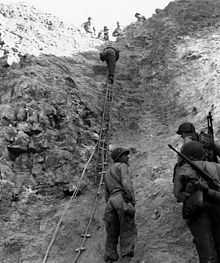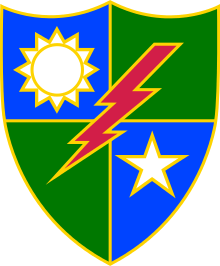2nd Ranger Battalion (United States)
| 2nd Battalion, 75th Ranger Regiment | |
|---|---|
|
2nd Ranger Battalion shoulder sleeve insignia | |
| Active | 1943–45, 1974 – present |
| Country |
|
| Branch |
|
| Type | Light infantry |
| Role | Special operations |
| Size | Battalion |
| Part of |
|
| Garrison/HQ | Joint Base Lewis-McChord, WA |
| Nickname | Rangers |
| Engagements |
World War II
Operation Just Cause Operation Enduring Freedom Iraq War |
| Commanders | |
| Notable commanders | James Earl Rudder |
The 2nd Ranger Battalion, currently based at Joint Base Lewis-McChord south of Seattle, Washington, United States, is the second of three elite special operations commando battalions belonging to the United States Army's 75th Ranger Regiment.
History
World War II

On 1 April 1943 the 2nd Ranger Battalion was formed at Camp Forrest, Tennessee, along with the 5th Ranger Battalion. Both battalions were officially activated in September 1943 and shipped to Great Britain where they were prepared for Operation Overlord as part of six Ranger battalions of the Second World War.
On 6 June 1944, Dog, Easy, and Fox Companies, commanded by Lt. Colonel James Rudder, landed at Pointe du Hoc from LCA landing craft and specially modified DUKW "Ducks" operated by the Royal Navy. The 225 Rangers had set off from Britain to launch an assault upon the cliffs overlooking the English Channel. In order to over-strength the 2nd Battalion, members of what was formerly the 29th Rangers were assigned as well. (needs citation)
Several landing craft containing Rangers and supplies capsized in the stormy waters and many Rangers drowned due to heavy equipment, but others were saved and hoisted into other DUKWs to participate in the attack. The Rangers had planned to land at the base of the cliffs at 0600 hours, however, because of a navigational error, they landed nearly an hour late. This cost the lives of more Rangers as well as the element of surprise. During the attack, the 190 remaining Rangers scaled the cliffs utilizing rope ladders, but only 90 Rangers were still able to bear arms after two days of relentless fighting. During the assault, 2nd Battalion managed to disable a battery of 155mm French artillery captured by the Germans, which was their primary objective. These guns were to be aimed at Utah Beach, however, the Rangers prevented their use, saving American lives on the shores of Normandy.
Meanwhile Able, Baker and Charlie Companies landed along with the 5th Rangers, the 1st Infantry Division and the 29th Infantry Division at Omaha Beach. They suffered heavy casualties but were able to complete their D-Day objectives. The 2nd Rangers were later involved in the Battle for Brest and the Battle of Hurtgen Forest where they led the assault on Hill 400, Bergstein. The battalion was deactivated after the war together with the 5th and 6th Battalion.
Modern
The 2nd Ranger Battalion was reactivated on October 1, 1974, as an elite combat unit eight months after 1st Ranger Battalion. The 2nd Ranger Battalion's colors and lineage was passed from Company H, 75th Infantry Ranger/Company E, 52nd Infantry (LRP), of the Vietnam War--the most decorated and longest-serving unit in LRP/Ranger history.[1]
The modern Ranger battalions are strategic assets, prepared to conduct missions short-notice worldwide. In 1984 the battalion became part of the newly formed Special Operations Command, 75th Ranger Regiment. The 2/75th participated in Operation Urgent Fury in October 1983. During the invasion of Grenada, the 2nd conducted a low-level parachute assault (500 feet), seized the airfield at Point Salines, rescued American citizens at the True Blue Medical Campus, and conducted air assault operations to eliminate pockets of resistance.[2]
In December 1989 the battalion took part in Operation Just Cause. The 2nd and 3rd Ranger Battalions and a regimental command and control team, conducted a parachute assault onto the airfield at Rio Hato, to neutralize the Panamanian Defense Force rifle companies and seize General Manuel Noriega's beach house. Following the successful completion of these assaults, Rangers conducted follow-on operations in support of Joint Task Force (JTF)-South. The Rangers captured 1,014 enemy prisoners of war (EPW), and over 18,000 arms of various types. The Rangers sustained 5 killed and 42 wounded.[2]
In October 2007, a D Company was added to all 3 battalions of the 75th Ranger Regiment.
Primary tasks include: direct action, national and international emergency crisis response, airborne & air assault operations, special reconnaissance, intelligence & counter intelligence, combat search and rescue, personnel recovery & hostage rescue, joint special operations, and counter terrorism.
Unit awards and streamers
The 2nd Battalion has earned numerous unit awards and battle streamers.[3] Among them are:
- Presidential Unit Citation (Army), Streamer embroidered EL GUETTAR
- Presidential Unit Citation (Army), Streamer embroidered SALERNO
- Presidential Unit Citation (Army), Streamer embroidered POINTE DU HOC
- Presidential Unit Citation (Army), Streamer embroidered SAAR RIVER AREA
- Presidential Unit Citation (Army), Streamer embroidered MYITKYINA
- Presidential Unit Citation (Army), Streamer embroidered VIETNAM 1966–68
- Valorous Unit Award, Streamer embroidered VIETNAM – II CORPS AREA
- Valorous Unit Award, Streamer embroidered VIETNAM – BINH DUONG PROVINCE
- Valorous Unit Award, Streamer embroidered VIETNAM – CAMBODIA FISH HOOK 1970
- Valorous Unit Award, Streamer embroidered VIETNAM – III CORPS AREA 1969
- Valorous Unit Award, Streamer embroidered VIETNAM – III CORPS AREA 1971
- Valorous Unit Award, Streamer embroidered VIETNAM – THUA THEIN-QUANG TRI PROVINCES 1968
- Valorous Unit Award, Streamer embroidered GRENADA 1983
- Meritorious Unit Commendation (Army), Streamer embroidered VIETNAM 1968
- Meritorious Unit Commendation (Army), Streamer embroidered VIETNAM 1969
- Meritorious Unit Commendation (Army), Streamer embroidered VIETNAM 1969–70
- Meritorious Unit Commendation (Army), Streamer embroidered PACIFIC AREA
- Joint Meritorious Unit Award, Stream embroidered PANAMA 1989
- Valorous Unit Award, IRAQ[4]
- Valorous Unit Award, AFGHANISTAN[4]
Notable 2nd Battalion alumni
- Specialist Tim Abell, television and movie actor; served in Charlie Company 2/75 as an enlisted man in 1976–1979.
- First Lieutenant John P. Abizaid served as a Platoon leader 1975–1976 in Alpha Company and later as the XO of Charlie Company from 1976 to 1977. He went on to command Central Command in the second Gulf War, taking over from General Tommy Franks. His change in intelligence methods led to the capture of Saddam Hussein. He retired as a General.
- LTC John J. Ellis served as the 2nd Ranger Battalion commander from 1985-1987. Rangers in his unit, SSG William Ulibarri and SGT Ross Willson won the Best Ranger competition in 1987. Col(r) Ellis is now retired from the Army and living in Virginia. He was inducted as a Distinguished Ranger in 1996.
- Lieutenant General David Barno, commanded 2nd Ranger Battalion from 1993 to 1994. Later became Commander, Military Operations-Afghanistan.
- Lieutenant Colonel Wayne A. Downing was the third Battalion Commander of the 2nd Ranger Battalion, and eventually commanded the 75th Ranger Regiment, and Special Operations Command. He retired as a General.
- Command Sergeant Major Frank Grippe, served for many years in the battalion and was latter the CSM of Central Command.
- Captain Gerald Heaney, WWII, landed at Normandy on the early hours of D-Day, Heaney was one of only three still on the front lines with the Rangers on VE Day. He served for nearly forty years as a federal judge on the United States Court of Appeals for the Eighth Circuit.
- Captain Robert L. Howard was nominated for three Medals of Honor for his actions in Vietnam. Two were downgraded, and he did earn one. Howard commanded Alpha Company from approximately 1975–1977. Howard was later inducted into the Ranger Hall of Fame.
- Sergeant First Class Matt Larsen, father of the Modern Army Combatives system, founder of the United States Army Combatives School.
- Second Lieutenant Leonard Lomell, served as platoon leader during the D-Day landings. Was awarded the Distinguished Service Cross for his actions.
- Sergeant First Class Leroy Petry, Medal of Honor recipient in the War in Afghanistan[5]
- Colonel James Earl Rudder, commander of the 2nd Ranger Battalion during World War II, later major general USAR and president of Texas A&M University, led the Ranger assault on Pointe du Hoc on D-Day.
- Sergeant First Class Randy Shughart, Medal of Honor recipient sniper who was killed during the Battle of Mogadishu.
- Corporal Pat Tillman, an American football player who left his NFL career and enlisted in the United States Army in May 2002 and was killed on 22 April 2004.
- Sergeant Stephen Trujillo, awarded the Silver Star during Operation Urgent Fury, the first Silver Star awarded since Vietnam, after rescuing fellow Rangers from a downed aircraft while under direct enemy fire.
- General Stanley McChrystal, commanded 2nd Ranger Bat from 94 to 96, later went on to Command US and ISAF forces in Afghanistan
- Command Sergeant Major Jeff Mellinger served as a platoon sergeant in B company circa 1981. He was the last active duty enlisted draftee soldier left in the United States military when he retired on 31 December 2011.
- Staff Sergeant Ronald Christopher was chosen by the 1st Cavalry Division G2 to train and lead the first LRRP team of the Cavalry Division on Nov 1, 1966.
- Sergeant Mathew "Mat" Best (b. Oct. 2, 1986), served as fireteam leader and platoon master breacher in Alfa Company (2004–08) during OIF and OEF-A. He's a 5-time combat veteran and has bachelor's degree in liberal arts. Known for his YouTube channel MBest11x and Article 15 Clothing company.
- SFC Jason Everman, musician best known for playing in grunge bands Nirvana and Soundgarden before enlisting in 1994.
See also
- H Company, 75th Infantry (Ranger) - 2nd Battalion's lineage
- Ranger Assault Group
References
- ↑ Ankony, Robert C., "H Company 75th Ranger / Company E, 52nd Infantry (LRP) 1st Cavalry Division," Patrolling magazine, Fall 2013: 12-13.
- ↑ 2.0 2.1 http://www.globalsecurity.org/military/agency/army/2-75rr.htm
- ↑ http://www.soc.mil/75thrr/75thrrcmpns.html
- ↑ 4.0 4.1 David Poe (15 May 2012). "Army Rangers hold rare public ceremony to celebrate service, sacrifice". Northwest Guardian. United States Army. Retrieved 5 November 2012.
- ↑ "Army Ranger to be awarded Medal of Honor". Stars and Stripes (Washington, D.C.). 31 May 2011. Archived from the original on 31 May 2011.
External links
- Brief history since reactivation in 1974
- List of 2nd Battalion Rangers killed
- 2nd Battalion, 75th Ranger Regiment – United States Army website
| |||||||||||||||||||||||||||||||||||||||||||||||||
Further reading
- "Pointe Du Hoe 2d Ranger Battalion". Small Unit Actions. American Forces in Action Series. United States Army Center of Military History. 1946. CMH Pub 100-14.

